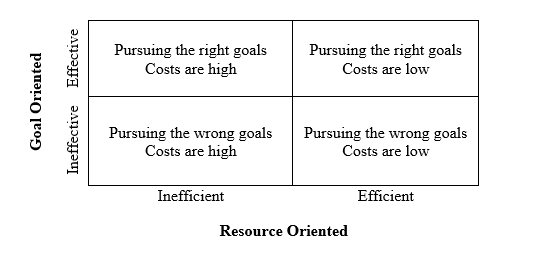Last week we discussed 5 Things Great Leaders Do.
This week we are going to discuss efficiency vs. effectiveness.
Let’s look at an example.
Every business has to move prospects through some process to convert them to a sale and close deals. And there are efficiency and effectiveness measures that can be applied to this process.
For example, two sales reps, Bill and Ted, each have a list of 100 prospects to contact after a tradeshow. Bill calls through the entire list in 4 hours and Ted calls through the list in 8 hours. Bill sets 10 appointments and closes 3 deals over the phone and Ted sets 20 appointments and closes 6 deals over the phone. Who is more efficient and who is more effective?
To answer these questions, it helps to review the definitions of efficient and effective, here they are.
Efficient – maximum productivity with minimum wasted effort, working in a well-organized and competent way
Effective – successful in producing a desired or intended result
Who is more efficient?
Efficiency is a matter of completing a task in a timely manner, with minimum wasted effort. So if Bill called through the list of 100 prospects in 4 hours and Ted called through his list of 100 in 8 hours, then Bill was more efficient in completing the task of calling through the list.
Who is more effective?
Effectiveness is directly related to producing a desired or intended result. So, if Bill moved 13 of his prospects (10 appointments and 3 closes) to the next stage and Ted move 26 of his prospects (20 appointments and 6 closes) to the next stage, then Ted was more effective in getting a desired result.
And looking at this example, it may appear that you would want Ted on your team over Bill, who wouldn’t, he was twice as “successful”. But what if you find out that Ted’s 6 closes were all for entry level products averaging $500 each and Bill’s 3 closes were all for advanced products averaging $2000 each.
The key to balancing efficiency and effectiveness is in the expectations – what is the desired goal?
In this example, there are several possible goals that could be perceived by Bill and Ted:
- Complete the task of calling through the prospect list
- Maximize the numbers of contacts that move to the next stage of the buying cycle
- Maximize the revenue dollars on these calls
Which is more important? It depends, right. It depends on the purpose of the calls and the cost of doing business. This may be a better way to visualize it:

Efficiency and effectiveness are both part of the bigger picture, and you should focus on the top right quadrant – effectively pursuing the right goals and efficiently maintaining costs, by not wasting time, leveraging technology where appropriate and aligning everyone on the team to work in the same direction.
So that begs the questions, does your team know what goal they are trying to achieve? And what resources they have at their disposal?
Stay tuned as we continue to share more about success and business fundamentals.
Subscribe here to keep in touch with Spray Foam Advisor and get your FREE copy of 25 SPF Frequently Asked Questions and a PRIVATE link to Robert Naini’s SPFA Breakout Session, “3 Ways to Close More Sales with Building Science.”


